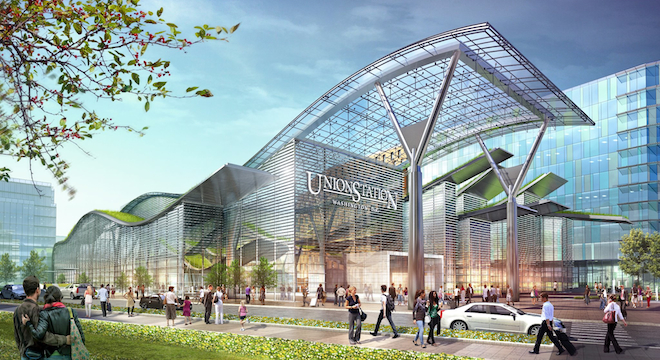Amtrak, the government-owned national railroad corporation, on Wednesday announced plans to transform Washington D.C.’s Union Station into the rail hub of the future that will see double the number of trains and triple the number of passengers that can be accommodated.
The “Union Station Master Plan,” would cost between $6.5 and $7.5 billion and the construction of the new facilities would take place over the next 15 to 20 years, according to Amtrak.
“Today’s plan ensures that Union Station will continue to serve as the gateway to our nation’s Capital, providing growing numbers of passengers with even greater transportation options,” said Deputy Secretary of Transportation and USRC Chairman John Porcari in a statement.
Specifically, Amtrak wants to take the 20 existing train platforms at Union Station, each of which are 20 feet wide or shorter, and dramatically widen them, increasing the number of passengers and trains they can handle.
The Union Station overhaul also calls for building a new “train shed,” expanding and adding a new “glazed roof” to the existing passenger concourse to let in natural light, building two new passenger concourses filled with retail space and a connection in between the upcoming Burnham Place development, a mixed-retail and residential space, all of which is all expected to go up to the existing station’s north side.
Here’s an artist’s rendering of the inside of the new version of “concourse A,” the existing passenger concourse, provided by Amtrak:

More artist’s renderings of Amtrak’s proposed new passenger concourse:


Another rendering from Amtrak, this of the view of the Main Hall from H Street:

See these and other illustrations on Amtrak’s Facebook page.
Amtrak said it has been working Akridge, the company behind the Burnham Place development, on integrating that project with Union Station.
“This project will be transformative for the entire Washington region,” said Akridge
Chairman Chip Akridge in a statement. “It will touch residents and visitors alike by creating an iconic transportation hub that integrates housing, offices and neighborhood shopping. Akridge is proud to be part of the Amtrak plan and looks forward to making this vision a reality.”
In order to make room for all of the new structures, Amtrak proposes knocking down the existing parking deck to the station’s west, built in the 1970s, and replacing it with underground parking. The new Union Station would also connect passengers to streetcar services and new bicycle parking and bike-shares, in addition to the taxi and bus service currently at the station.
If all goes according to plan, eventually the new Union Station would be able to accomodate high-speed trains as well, part of Amtrak’s overall $151 billion plan to build high-speed rail along the Northeast Corridor between Boston and Washington, D.C., through New York’s Penn Station.
In that sense, Amtrak’s D.C. visions are inexorably linked to what happens in other metropolitan areas. An Amtrak representative in New York pointed out that “Penn Station is already at capacity, there isn’t any additional room,” for the new passengers that would arrive from D.C. if the Union Station plan goes through, unless Amtrak New York’s own proposed Gateway Tunnel project also gets off the ground.
“Gateway is still in its preliminary phases, the funding still hasn’t been secured,” Amtrak’s New York rep told TPM.
Amtrak still isn’t exactly sure who will pay for the Washington Union Station project, either.
The master plan appears to lobby the District government and those of surrounding states, stating that: “By making this investment into Washington Union Station, the city and region receive enormous benefits,” including an estimated $13.5 to $15 billion added to the D.C.-area economy over the construction period and some 7,000 new full-time jobs as well as 3,000 construction jobs.
An Amtrak national spokesperson told TPM that the Union Square remaking “will likely be financed through a combination of public and private funding sources.”
Pushing hard for the money, Amtrak notes in its mater plan that the plan would “knit the city of Washington together in a way that has not been possible for 100 years.”






